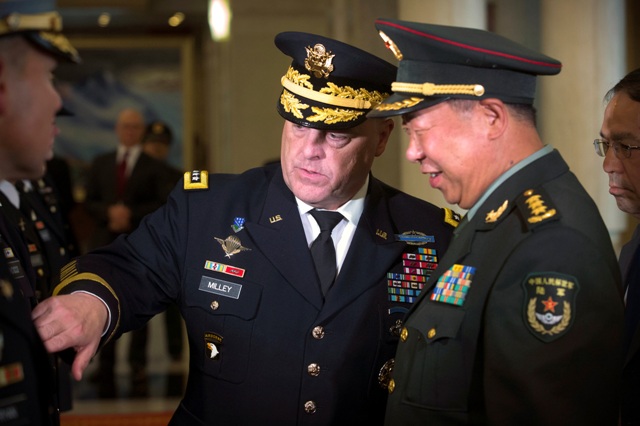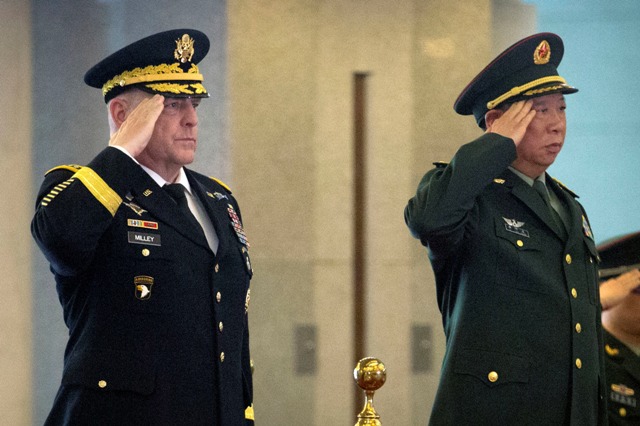From Foreign Policy (Aug 16):
Here's How the Philippines can Win in the South China Sea (By James Holmes)
A third-century Roman dictator may have the answers.

The Philippine Islands has a problem. It has international law on its side in its quarrel with China over maritime territory, but no policeman walking his beat to enforce the law. That means that, despite an
international court’s findings, the dispute over rocks and islands off Philippine shores is far from over. On Aug. 2, China’s defense minister, Chang Wanquan, even
said China must prepare for a “people’s war” at sea. That leaves strategy as Manila’s lone recourse; yet China overshadows the Philippines in every imaginable metric of national power.
But as I
wrote in 2012, when South China Sea tensions were heating up, while the Philippines has “no chance of winning in combat” with China, “it may win a peacetime confrontation.” The hope for Philippine leaders, then as now, was to conjure the career of Fabius Maximus, the Roman dictator nicknamed “Cunctator,” or “the Delayer.” Fabius advised confounding antagonists through inventive strategy and tactics, constructing alliances to augment strength, and remaining united and resolute at home.
The Delayer spoke from experience. Greek historian
Plutarch relates how Fabius envisioned combating Hannibal, who “burst into Italy” across the Alps in 218 B.C. and went on a rampage. Romans, accordingly, granted Fabius emergency powers to repel the threat. Fabius appeared unperturbed despite the menace in Italy’s midst. He reasoned that given time, Rome could amass power sufficient to vanquish the invaders. So he abjured efforts to crush the Carthaginians in an afternoon and postponed a battlefield decision.
The Fabian playbook is essentially this: (1) Exercise self-discipline, subduing your passion for quick victory. Refuse to fight a stronger foe on its own terms. (2) Keep your alliances robust, supplementing your strength. (3) Tend to the home front, sustaining political unity for a prolonged struggle while husbanding the sinews of national power. And (4) be patient. Let the foe exhaust its fervor over time, yielding an acceptable peace.
It’s likely Fabius would have smiled at Manila’s courtroom triumph. It’s precisely the sort of stratagem he would have deployed when confronting a power mismatch.
It’s likely Fabius would have smiled at Manila’s courtroom triumph. It’s precisely the sort of stratagem he would have deployed when confronting a power mismatch. Unable to dissuade a muscle-bound China through diplomatic persuasion or overpower it through economic or military might, Philippine officials took their case to the
International Tribunal for the Law of the Sea (UNCLOS), which last month
struck down Beijing’s claim to de facto ownership of most of the South China Sea — including much of the Philippine “
exclusive economic zone” (EEZ), the offshore belt of sea where coastal states enjoy exclusive rights to harvest natural resources from the water and seafloor. Most strikingly, the jurists pronounced Beijing’s map of Southeast Asia, which bears a “
nine-dash line” enclosing most of the South China Sea and delineating waters where China claims “
indisputable sovereignty,” as bunk.
Under the doctrine of indisputable sovereignty, China would make the rules governing seaborne endeavors in the South China Sea.
The logic behind China’s stance was simple: the warrior who does battle on unfamiliar ground fights at a marked disadvantage relative to the warrior fighting on home ground. China wants to keep prospective foes like the U.S. Navy from knowing the theater’s physical terrain and underwater geography, and to keep them from working with Southeast Asian allies before the outbreak of war. If successful, it can cripple its rivals operationally.
But while the UNCLOS tribunal ruled China’s overreach unlawful, the court has no enforcement arm. China refused to take part in the legal proceedings,
rejected the ruling, and, for good measure,
flew a nuclear-capable bomber over Scarborough Shoal afterward, which the Chinese coast-guard vessels
wrested from the Philippine Navy four years ago, precipitating the dispute.
Confronted with Chinese intransigence, Philippine leaders need to go back to Fabius’ playbook.
Having seized control of the narrative, for one thing, Manila must hang onto it. China wages “three warfares” 24/7/365, employing media, psychological, and legal outlets to mold opinion in its favor. The Philippines must reply in kind, telling its story well and telling it often. The UNCLOS tribunal ruling should become a standard talking point.
And spokesmen must fold pictures and video into Philippine public diplomacy. I am a close watcher of South China Sea issues, but I have yet to unearth a slick, visually impressive statement about the problem and how Philippine policy addresses it. For instance, Manila’s
initial official account of the Scarborough Shoal standoff, dating from April 2012, shows a few grainy pictures of boats containing contraband coral, clams, and sharks harvested from the waters around the shoal. There is nothing to put the standoff in context — say, by showing the Philippine Navy facing off against Chinese fishing and law-enforcement vessels. Nor does the shoal itself appear. That set an unfortunate pattern for Philippine public diplomacy from then until now.
Manila must show people what China is doing and, in the case of fellow Asian powers, remind them they may be next if China gets away with grabbing something just because it can.
Second, Fabius beseeched Rome to nurture its alliances, a major reserve of Roman power.
Manila must likewise aim its opinion-shaping efforts at current and prospective partners. It has no military option of its own. After all, the Philippine Navy is centered on
three elderly U.S. Coast Guard cutters painted gray and renamed frigates. China’s navy would make short work of them in battle.
In this regard, multinational bodies offer little promise.
The UN Security Council could act. But China is a permanent member of the Security Council, wielding veto power over any resolution. ASEAN could act, but it isn’t a military alliance, and its members make decisions by consensus in any event. (Just last month, Cambodia
nixed an effort to release a joint statement heralding the UNCLOS tribunal’s decision.)
That leaves formal or informal alliances. A
mutual defense treaty has bound the United States to the Philippine Islands since 1951. The pact obliges America to defend not just the main islands but “island territories under [Manila’s] jurisdiction.”
Washington has inched closer and closer to declaring that the treaty applies to offshore islands and atolls, as well as underwater features such as Scarborough Shoal. But it hasn’t quite gotten there. Until then, Philippine President Rodrigo Duterte should beware of hinting that he might barter away the contested territory, which is one very plausible outcome of one-on-one negotiations. Why would the U.S. bother defending something its ally might give away? Stand firm, Mr. President — and let friendly powers see you do so.
That will help with Fabius’ third strategic imperative: steadying the home front for a long struggle.
The Philippine electorate, like those anywhere, will come down hard on national leaders who appear to be dickering away sovereign rights and dignity.
The Philippine electorate, like those anywhere, will come down hard on national leaders who appear to be dickering away sovereign rights and dignity. The good news is that Duterte appears to have internalized this lesson since taking office. In the wake of the UNCLOS tribunal’s ruling, Duterte told a visiting U.S. congressional delegation that the court’s decision is “non-negotiable.” That’s a message that will resonate with Philippine constituents as well as abroad.
Lastly, Fabius would counsel Philippine leaders to protract the competition until China’s fervor subsides. How long will that take, and will China abandon its aims at all? It’s hard to see how Beijing could ever formally give them up. Chinese Communist Party leaders staked national dignity and prestige on an empty claim to ownership of the maritime common. They portrayed the common as sacred territory that has belonged to China since antiquity, and made themselves
accountable to nationalist sentiment — which they themselves set ablaze.
The best the Philippines and its friends can hope for is that Beijing will mellow out over time. It can never cancel its maritime claims altogether, for fear of fueling popular fury. But it could, perhaps, shelve them quietly for the sake of regional amity — as party potentates like Deng Xiaoping once did. Beijing could stop pressing its claims day in and day out.
To be sure, students of Roman history would affix a coda to all of this, pointing out that Fabius didn’t win Rome’s war against Hannibal;
Cornelius Scipio did. Fabian strategy wasn’t enough. Fabius had to defend himself constantly from hotheads thirsting for decisive victory, and Florentine philosopher Niccolò Machiavelli
opined that Fabius proved unable to escape his defensive-minded instincts. Rome needed a Scipio: a brash, offensive-minded, risk-taking commander. Scipio carried the fight across the Mediterranean Sea, marching on Carthage itself. Scipio’s army
crushed Hannibal in North Africa, at the Battle of Zama, putting an end to the Second Punic War and earning the honorific
Africanus for his exploits.
That endgame hints at the frustrations awaiting Manila. With no Scipio in waiting, Manila must resign itself indefinitely to stalling tactics. It must be more Fabian than Rome was, placing heavy emphasis on its alliances.
Then again, lesser antagonists have used just this strategy many times over the centuries, sometimes with rousing success. Look no farther than American shores. In 1777, Alexander Hamilton — who
served on George Washington’s staff and reformed the Continental Army before becoming a
star of stage and screen —
boasted to Robert Livingston about the army’s “Fabian conduct.” Rather than offer battle, and perhaps lose the Revolutionary War in an afternoon, Hamilton urged American forces to “perplex and fret” the redcoats. In so doing, Washington & Co. would “precipitate” British commanders “into measures” that Americans could “turn to good account.”
“Our business,” concluded Hamilton, “is to avoid a general engagement and waste the enemy away by constantly goading their sides, in a desultory teasing way.” In the meantime, the colonists tapped European help to construct a fighting force capable of facing British redcoats.
Speaking of America: if a Scipio-like commander capable of deterring or vanquishing China appears, it will probably be in the form of an American naval commander. That should concentrate minds in Manila. Staying on good terms with one’s superpower patron is sound strategy. Reassuring Washington of Philippine steadfastness, liberalizing U.S. military access to bases close to likely scenes of action, and widening Manila’s circle of allies represent obvious steps for Duterte and his advisers.
Entrusting vital interests to foreigners is less than satisfying for a proud society like the Philippines. The Philippines would surely have preferred to declare victory after years of Fabian strategy yielded a legal ruling starkly in Manila’s favor. But such is life when small powers square off against big ones. It’s time to dust off the Fabian playbook once again.







